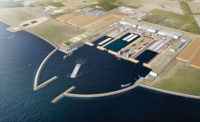Even with transformational tech tools to speed results for next-generation project and organization leaders, their personal motivation and connections are key to success, design and construction sector veterans and rising professionals agreed at a recent ENR leadership forum.
Transitioning into a position with greater responsibilities is often "overwhelming" and "chaotic" because employees often shift from one role to the next without much guidance, Tracey Smith, a principal and organization development expert at industry management consultant FMI, told attendees at the ENR Emerging Leaders Forum in Chicago. The event included recognition of ENR'sTop 20 Under 40 Young Professionals for 2024.
She said the hardest transition for new leaders is from micromanaging daily technical tasks to focusing on overall project or organization business health and long-term planning—noting also the extra challenge of the mindset shift in a “problem-solving technical industry.”
Sheryl Van Anne, Mortenson vice president and general manager, urged industry entrants to “sit in different seats” in the career development process. “Having exposure to the different parts of the industry will help you decide which one naturally feels more exciting to you,” she said.
Launching the Chicago chapter of Professional Women in Construction has helped regionally-based women professionals boost that career movement through networking, said Karrie Kratz, vice president and business unit leader at Gilbane Building Co. The group now has a formal mentoring program that “opens up doors and connects women to others who … can give advice about a new area of interest,” she noted.
For Rod Jones, a Holder Construction manager and one of the Top 20 recognized, training his team to work independently enabled him to join the ENR event even as “my project is still going,” he said. “I'm comfortable that I don't have to check in.” Leaders have to "get their heads out of the weeds .... to see the horizon, set the vision for the team and remove roadblocks,” Jones noted. Benjamin Markham, president of acoustics consultant Acentech and a former awardee, said leaders have to “put your own ego in check and develop your people.”
Irene Turletes, another current awardee who is an HDR water resources market sector lead, said she had to redefine “what success was” in stepping into a business role—emphasizing that it now relates to helping team members seek work and assisting “their clients to complete their projects and deliver their own mission.”
Broader Scope
KiSeok Jeon, vice president and digital advisory lead at consultant STV, told attendees how he soon realized his career path was not in traditional design. "This led me to look at … bigger scope," he said, which evolved into design automation "from an organizational perspective." STV leadership empowered him to lead its three-year digital transformation, creating an advisory practice that has a holistic impact on all firm operating groups, KiSeok said.
"You don't spend your time coveting a role or position. You immerse yourself in the craft of being a leader," STV CEO Greg Kelly emphasized to attendees, adding that employers “have taken a bet on you because you've done something unique and have distinguished yourself."
KiSeok said he now oversees a team of 24 employees who provide services and skills to clients and to the broader STV team that include consulting, architectural and engineering technology, product solutions development and data science.
Technology transformation impact on design and construction processes and services will only grow, said Burcin Kaplanoglu, innovation head at Oracle Industry Labs, citing a new U.K. architects' group report that said artificial intelligence has been used by more than 40% of its members. He said use of machine learning for robotics would play a "huge role" amid the ongoing industry labor shortage.
"Having robots in construction areas is very visual, and is going to change the whole economic structure of the industry," said Jennifer Suerth, Pepper Construction Group senior vice president of virtual construction, MEP and operations technology. She pointed to a major impact in risk management.
Despite some disruption of industry practices by generative AI, Kris Lengieza, vice president of global partnerships and alliances at technology firm Procore, urged attendees to explore new use opportunities in project management.
“How can we use data to really drive better project outcomes and make better decisions?” asked Aleksey Chuprov, Suffolk Construction data analytics vice president. Tracking data in a centralized dashboard "allows our project teams to make adjustments in real time,” said Amy Jones, Skanska USA director of data analytics.
Rupert Motwani, programs initiations lead for Jacobs' Americas East group, added that tracking and analyzing data across projects, especially large ones, is key to improving outcomes and "building a consistent approach" to program delivery.
Project Collaboration in Action
Emerging leaders agreed that being part of a major project team at an early career stage has been a valuable experience.
As one of five contractors that is part of a minority-led joint venture building the Obama Presidential Center in Chicago, Powers & Sons Construction Vice President Kelly Powers Baria described work as a “unique opportunity to have a challenging build and a client committed to using it as leverage to transform the paradigm for what construction looks like.” She added: “From our understanding it’s the first time that a minority-led joint venture has built a project of such significance” in the city.
“It’s transformative, a once-in-a-lifetime opportunity,” added Kate Van Zeyl, vice president and general manager of Turner Construction Co., another team contractor.
Project leaders of 1000M, a 74-story, 1-million-sq-ft residential tower completed last year on Chicago’s Michigan Avenue, also shared the career-building value of teamwork and creative solutions to meet its various challenges—which included complicated structural elements and an eventual mandated redesign.
“To do a building like this is exactly why I chose this profession, and probably why a lot of structural engineers choose the profession,” said David Fields, senior principal at engineer Magnusson Klemencic Associates. Beyond the physics and other elements involved in building large projects, he added, “the heart of it is the collaboration."








Post a comment to this article
Report Abusive Comment